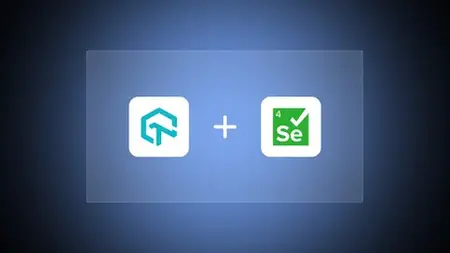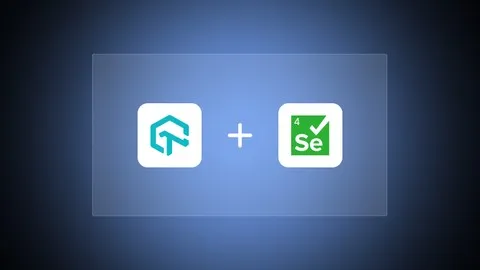Complete Selenium 4 Tutorial - Learn Selenium 4 In 6 Hours
Published 9/2024
MP4 | Video: h264, 1920x1080 | Audio: AAC, 44.1 KHz
Language: English | Size: 3.02 GB | Duration: 5h 18m
Published 9/2024
MP4 | Video: h264, 1920x1080 | Audio: AAC, 44.1 KHz
Language: English | Size: 3.02 GB | Duration: 5h 18m
This course on Selenium 4 covers all the essential topics you need to understand about the latest version of Selenium.
What you'll learn
You will learn how to effectively use Selenium 4 for web test automation.
New features and enhancements, such as the W3C WebDriver standard, Relative Locators, and Chrome DevTools Protocol integration.
Learn how to handle multiple browser windows and tabs, set up and use the revamped Selenium Grid for parallel testing.
Learning strategies for writing efficient, maintainable, and robust test scripts to ensure high test coverage and reliability.
Requirements
Should have a basic understanding of web development concepts, including HTML, CSS, and JavaScript.
Familiarity with any programming language, preferably Java, Python, or C#, is recommended as the course involves writing test scripts. Prior knowledge of Selenium 3 or any other test automation framework will be beneficial but is not required, as the course covers all the foundational elements of Selenium 4.
Additionally, having a working computer with internet access to install and run Selenium, a web browser, and an integrated development environment (IDE) like IntelliJ, Eclipse, or Visual Studio Code will be necessary for hands-on practice.
Description
In this Selenium 4 course, you'll explore the new features and enhancements with detailed tutorials for a deeper understanding. This tutorial covers the following topics:How to upgrade from Selenium 3 to Selenium 4? What are Relative Locators? What is Chrome DevTools Protocol (CDP)? Insights into Enhanced Selenium Grid and Selenium IDE How to do Geolocation and Responsive Testing using CDP? How to perform network interception and emulation using CDP ?Troubleshooting tests and capturing performance metrics using CDPSelenium 4 is the latest version of the popular open-source test automation tool, bringing significant updates and new features to enhance web testing capabilities. One of the major changes in Selenium 4 is full compliance with the W3C WebDriver standard, which improves cross-browser compatibility and reduces test flakiness by standardizing browser communication. This ensures more consistent behavior across different browsers like Chrome, Firefox, Safari, and Edge.Selenium 4 introduces Relative Locators, allowing testers to find elements more intuitively by using other nearby elements as references, such as above, below, to the left of, to the right of, or near. The new Chrome DevTools Protocol (CDP) integration enables advanced browser manipulation and debugging features like network interception, simulating network conditions, and capturing console logs.The Selenium Grid has been revamped to provide a more scalable and efficient architecture for parallel test execution across multiple environments, now with a user-friendly GUI and support for Docker. Selenium 4 also features improved support for multiple browser windows and tabs, allowing for more sophisticated test scenarios.These enhancements make Selenium 4 a more powerful tool for developers and testers, streamlining test automation workflows and improving the reliability of web applications across different platforms and browsers.
Overview
Section 1: Introduction
Lecture 1 Introduction
Lecture 2 Updating Project Dependencies
Lecture 3 Switching from Capabilities to Options
Lecture 4 Using Remote WebDriverBuilder
Lecture 5 Changes in Actions Class
Lecture 6 Timeout Getters Updates
Lecture 7 Find Element Utility Methods Removal
Lecture 8 Understanding Element Attributes vs. Properties
Lecture 9 Potential Errors & Deprecation Messages
Section 2: Relative Locators
Lecture 10 What are Relative Locators?
Lecture 11 Different Types of Relative Locators
Lecture 12 Chaining Relative Locators
Section 3: Using Chrome DevTools Protocol (CDP)
Lecture 13 Introduction to Chrome DevTools Protocol
Lecture 14 jGrow notifications Implementation
Lecture 15 jGrow notifications via Chrome DevTools Protocol
Lecture 16 Extending WebDriver with EventFiringDecorator
Lecture 17 Elements highlighting Implementation
Lecture 18 Elements highlighting and jGrow notifications in LambdaTest
Section 4: Selenium Grid And Selenium IDE
Lecture 19 What is Selenium Grid ?
Lecture 20 Selenium IDE Demo
Lecture 21 Control Flow Commands
Lecture 22 Test Data Preparation
Lecture 23 Implement Element Hover + Delete
Lecture 24 Run Tests from CLI
Section 5: Geolocation Testing Using Chrome DevTools Protocol
Lecture 25 Geolocation Testing using BiDi/CDP
Lecture 26 What is Localization Testing ?
Lecture 27 What is GeoTagging ?
Lecture 28 What is GeoBlocking ?
Lecture 29 Geolocation Testing using Chrome DevTools Protocol
Section 6: Responsive Testing Using Chrome DevTools Protocol
Lecture 30 What is Responsive Testing ?
Lecture 31 Demonstration of How to do Responsive Testing with CDP in Selenium 4
Section 7: Troubleshooting Tests With CDP And BiDi APIs
Lecture 32 Features of CDP and BiDi API
Lecture 33 What is Mutation Observation ?
Lecture 34 How to check JavaScript Exceptions using CDP ?
Lecture 35 How to listen to console.log events in Selenium 4 ?
Section 8: Network Interception Using BiDirectional APIs
Lecture 36 Introduction
Lecture 37 Basic Authentication in CDP Selenium 4
Lecture 38 How to intercept the Network Traffic using BiDirectional APIs ?
Lecture 39 What is a Black Hole Pattern ?
Lecture 40 What do you mean by Mock API Calls ?
Lecture 41 How to capture HTTP traffic in Selenium 4 ?
Lecture 42 How to serve requests from cache ?
Lecture 43 What are Event Source Messages in web sockets ?
Section 9: Capturing Performance Metrics Using CDP
Lecture 44 Introduction
Lecture 45 Why should we do Performance Tests?
Lecture 46 Where to learn more about Performance Metrics?
Lecture 47 What are the important metrics to measure?
Lecture 48 How to use Lighthouse to generate Performance Reports?
Lecture 49 How to capture performance metrics with the LambdaTest platform?
Lecture 50 Demonstration of collecting performance metrics using CDP
Section 10: Network Emulation Using Chrome DevTools Protocol
Lecture 51 Introduction to the video
Lecture 52 Why do we need to emulate the network?
Lecture 53 How to emulate network in the browser via Chrome DevTools Protocol?
Lecture 54 What are Progressive Web Apps?
Lecture 55 CDP Emulate Network Java Code
Section 11: Test Result Analysis and Reporting
Lecture 56 Introduction
Lecture 57 Top Selenium test reporting tools
Lecture 58 Allure Framework
Lecture 59 ReportProtal.io
Lecture 60 Extent Reports
Lecture 61 GitHub Actions
Lecture 62 Conclusion
This course is ideal for software testers, quality assurance professionals, and developers who want to enhance their skills in web test automation using Selenium 4.,It is also suited for beginners who are new to Selenium and wish to learn its latest features and capabilities from scratch, as well as experienced Selenium users looking to upgrade their knowledge to the newest version.



